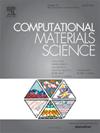Research on spatiotemporal prediction model of grain microstructure evolution based on VMamba network
IF 3.1
3区 材料科学
Q2 MATERIALS SCIENCE, MULTIDISCIPLINARY
引用次数: 0
Abstract
The evolution of microstructure is essentially a spatiotemporal prediction problem, so developing effective spatiotemporal models is crucial for accurately describing this process. It is of great significance to adopt deep learning techniques to accurately predict grain growth by learning the spatiotemporal characteristics of historical microstructure data, in order to address the problems of large computational complexity and high computational complexity in phase field method calculations. This study proposes a novel grain microstructure evolution prediction model, the Visual Mamba Grain Microstructure Evolution Prediction Model (VMmabaGP), which fully utilizes the powerful capabilities of VMamba Network and spatiotemporal attention mechanism to accurately predict the evolution process of grain microstructure. Based on this model, training was conducted on publicly available datasets for grain growth and self-made datasets for the microstructure evolution of Ni–Cu binary alloy dendrites. The dynamic evolution process of grain microstructure was predicted and the predicted results were compared and analyzed with the calculation results of traditional methods. The results showed that the grain growth prediction results were consistent with the phase field method calculation results. Comparing VMmabaGP with existing advanced models such as SimVP and TAU, the prediction performance was excellent, with an average MSE decrease of 57.4% and an average SSIM improvement of 43.7%, proving the high prediction accuracy and generalization ability of VMambaGP model on different datasets. The prediction results of the microstructure evolution of Ni–Cu binary alloy dendrites reveal the complex relationship between dendrite morphology and solid solute diffusion coefficient during the solidification process. In particular, this model has significantly improved computational efficiency, with a 400% increase compared to traditional phase field models. Therefore, it can solve the problems of high computational complexity and complexity in phase field calculations, demonstrating its enormous potential in multiple fields such as material design. The code dataset for this study can be obtained from the following URL https://github.com/ljj123-wed/VMmabaGP.

求助全文
约1分钟内获得全文
求助全文
来源期刊

Computational Materials Science
工程技术-材料科学:综合
CiteScore
6.50
自引率
6.10%
发文量
665
审稿时长
26 days
期刊介绍:
The goal of Computational Materials Science is to report on results that provide new or unique insights into, or significantly expand our understanding of, the properties of materials or phenomena associated with their design, synthesis, processing, characterization, and utilization. To be relevant to the journal, the results should be applied or applicable to specific material systems that are discussed within the submission.
 求助内容:
求助内容: 应助结果提醒方式:
应助结果提醒方式:


